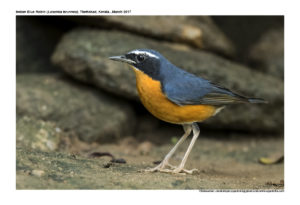Indian Blue Robin

Indian Blue Robin Luscinia brunnea
Etymology:
- Luscinia : Latin word for Nightangle
- Brunnea : Latin word for Brown
Vernacular Names :Lepcha: Manzhil pho, Mar: Bhartiyaniladayal
Distribution in India: Breeds in Himalayas and North East and winter visitor in South and North East India.
Description: Size of 13–15 cm; wt. of 14–20 g. The male of nominate race is slaty grey-blue from crown to tail, with white supercilium, blackish of face extending across neck side. It has a rufous-orange on throat to breast and lower flanks, mid-belly to vent is white, bill is black when breeding, otherwise brownish with pink base and legs are pinkish-brown. The female is olive-brown above, with rufescent rump, narrow buffy eyering, whitish below, with vaguely dappled fulvous breast and flanks. The juvenile is mid-brown above, indistinct buff spots on crown, buffy-white below, buff-spotted mid-brown breast and flanks.
Habitat: It breeds in moist closed forests, often cloud forest, with dense undergrowth of bushes, herbs, fallen logs and tangled vines like Rhododendron bushes,under lower broadleaf evergreen and higher conifer forest; in ravines or close to running water. During breeding it is found at 1600–3300 m. It winters in dank ravines and wet undergrowth along streams within evergreen forest, coffee plantations .In winter it can be seen from low level to 500 m.
Food habits: It eats invertebrates, small molluscs and insects and their larvae.It forages on ground in undergrowth, with rapid hopping runs.
Breeding habits: They breed in May–Sept in Afghanistan, May–Jul in Himalayas, May–Jun in China and Apr–May in Myanmar. The nest is small, bulky, untidy cup of moss, dead leaves, roots and dry grass, lined with fur, hair, feathers and sometimes pine needles, well concealed on ground, on bank in shady ravine, in low tree hole or fern clump, or among roots or stones. They lay a clutch of 3-4 Eggs.